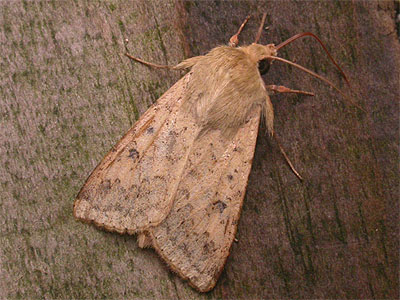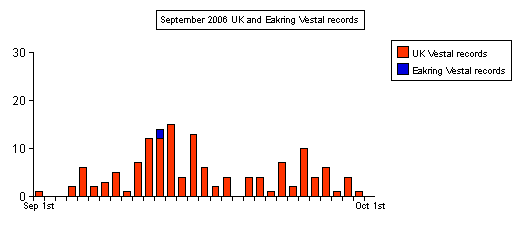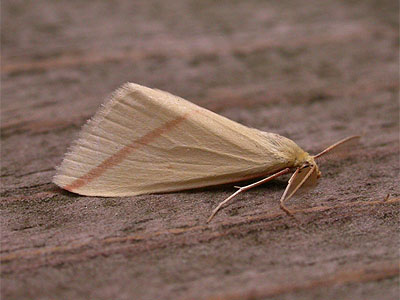

| Migrant moths at Eakring in September 2006 | ||
| September 2006 was a spectacular month for moth trappers across the UK. More importantly, the Eakring area also witnessed an exciting period of migrant activity. In most years, there have been just a handful of regular migrant species found in the area, but this year has been totally different. | ||
| ..... | ||
 |
Some 11 known migrant
species and three other potential migrants were either
recorded at light, netted, or observed nectaring at
Valerian in the area. It's difficult to say whether the variety of species that occurred will ever be repeated. We personally doubt it, but moth trapping is an unpredictable aspect of natural history study that no one can ever really be that sure. The specific targeting of migrants is even more unpredictable when you are trapping away from coastal areas, but it may now be just about possible to make an educated guess as to what's likely to turn up at the trap on future dates. The three main migrant influxes took place overnight on September 4th, a few nights later on the 9th and later in the month on the 23rd. The second and third of these were well predicted in advance. |
|
| ..... | ||
| 24 hour access to the latest weather forcast and predictions via the internet, now allows the modern-day lepidopterist to be alert for weather systems condusive to migration from southern Europe and Africa. On September 8th, such an alert was raised and by the following night, it was obvious that an increased number of migrants had also arrived in the Eakring area. As with migrant birds, the number of migrant moths inland is always far less than the concentrations found at coastal sites. The large rise in numbers at Eakring on the 9th, coincided nicely with arrivals on the UK's south and east coasts. It was obvious that many arriving moths had quickly filtered inland with assistance from the weather conditions. | ||
| Fig 1. September migrant arrivals in the UK. The graph below shows the occurrences of seven migrant species in the UK during September 2006 and that there were two major migrant arrivals into the UK during September - occuring on 4th and 9th. Most of the data comes from coastal sites. | ||
 |
||
| Fig 2. September migrant arrivals in the Eakring area. Occurrences of the same migrants in the Eakring area. Even with fewer nights trapping, the graph corresponds quite well to the that of the whole of the UK shown above. | ||
 |
||
| Fig 3. UK and Eakring Vestal records for September 2006. The graph shows the occurrence of two Vestal at Eakring, against those reported throughout the rest of the UK during September. The graph corresponds well to the UK migrant arrivals shown in Fig 1. | ||
 |
| ..... | ||
| Notable
dates - September 9th and 12th An evening visit to the Red Hill area on September 9th, saw a single Hummingbird Hawk-moth nectaring on Valerian. As dusk approached, the number of Silver Y's present increased to at least 60 moths when there had only been around 20 present over the preceding evenings. It was obvious that there had been a considerable arrival of new moths into the area and an even better indicator were the Bedstraw Hawk-moth and Scarce Bordered Straw that also appeared. Both these moths represented site (and personal) firsts, but because of the number of Scarce Bordered Straw that had appeared throughout the UK (including probably all inland counties by the end of the month) it was not unexpected. Unfortunately, this moth eluded capture, but another was present the next night and that was'nt missed. The Bedstraw Hawk-moth was in excellent condition and was originally thought to have been part of a second brood, resulting from arrivals earlier in the year. Both at Eakring and across the rest of the UK, the numbers of migrants attracted to light dropped over the next few nights. Silver Y's remained at Red Hill in slightly increased numbers and a second Scarce Bordered Straw was netted on the 10th, but it was'nt until the 12th, that another predicted wave of migrants reached the area. An evening's trapping on what was a warm September 12th, provided one of the best trapping sessions for several years. 183 moths of 35 species in 3h 00m trapping time (20:15-23:15h) were attracted to MV light. Included in this total were five species of migrants - three of which were new to the area. Five Diamond-back Moth, two Rush Veneer, two Vestal, and single Scarce Bordered Straw and Euchromius ocellea represented obvious highlights for the night. |
||
| ..... | ||
| Interestingly,
both Rush Veneers and Vestals arrived well into the
session and within quite a short time of each other. Also coming to light at about the same time was the Pyralid Euchromius ocellea, which remained unidentified until the following morning. We are still awaiting confirmation from the county recorder, but this is probably the first record of E. ocellea for Nottinghamshire. In addition to the above, other important catches on a county level were Small Mottled Willow (Lound Wood Sep 17th) Pearly Underwing (Red Hill September 24th) and two more Scarce Bordered Straw (Lound Wood September 23rd). Rush Veneers were again noted over a two day period later in the month, with five at Lound Wood 23/09/06, an adult by day at Eakring Flash 24/09/06, three at Red Hill 24/09/06 and another adult by day at Red Hill 25/09/06. |
 |
|
| ..... | ||
| Light-trapping just outside Lound Wood on
September 23rd provided another interesting night. With a
generally open aspect and with the wood being elevated
above the surrounding land, five Rush Veneer, four Silver
Y and two Scarce Bordered Straw were
seen to approach the trap from the south-west across the
open field. Interestingly, this was into the wind, where
earlier in the day, Red Admirals had been noted moving
through south. Perhaps this is confirmation that these
migrant moths were part of the UK influx which took place
on this night? Following a two week break in the records, Hummingbird Hawk-moths were again around the Eakring area during September. A particularly confiding individual was nectaring at Red Hill on the 9th, but the most favoured site was the old school house in Eakring village. Single adults were seen nectaring on Valerian there on September 12th,16th and 20th, with two present on 21st being the last sighting. Summary Nationally, there were low numbers of Rusty Dot Pearl and Bordered Straw and both these moths hardly feature in Fig 1 and 2. Vestal has been treated separately in Fig 3. The three main influxes generally included Silver Y, Rush Veneer and Scarce Bordered Straw. Pearly Underwing and Dark Sword-grass featured on, and over the nights following the September 9th and 23rd influxes, with few records early in the month. On the basis of these observations and trapping results, it seems that during exceptional influxes of single or multiple migrant species, there is an increased chance of a small number filtering well inland. The coming years will prove this or otherwise. |
||